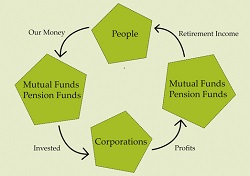|
People, Profits, & Pensions |
|
Texas State Employees & Tiffany's
Monday, March 24, 2014 What's New in Middle Class Ownership of Big Business
Texas state employees who participate in the Employees Retirement System owned 100,500 shares of Tiffany's at year-end 2013, shares valued at more than $9 million. Altogether, institutional investors (mainly pension funds, mutual funds, and insurance companies) owned 78.3% of Tiffany's shares at the end of 2013, according to nasdaq.com. And, on Friday the company had good news for the state employees and millions of others who own it. Here's what Tiffany & Co. had to say about the bottom line for 2013, "net earnings increased 15% to $481 million, or $3.73 per diluted share...." For 2014, the company expects earnings to increase to $4.05 to $4.15 per share. All of which will help the Employees Retirement System of Texas make pension payments to its current 92,000 retirees and 134,000 future retirees. Here's how Tiffany's describes itself at its website,
For more connections between working, middle class people and the world's biggest corporations, please visit our archives. The Bigger Picture:Will Profits from Big Macs Add to Your Retirement Income?In 1948, the McDonald brothers redesigned and remodelled their drive-in restaurant in San Bernardino, California. Taking inspiration from Henry Ford's assembly-line, they created the fast food revolution, with the quick service and low prices we now take for granted. In that same year, the U.S. National Labor Relations Board ruled unions could include pension issues in contract negotiations. That ignited a massive expansion of pension plans. In the 1950s, pension funds started buying stocks, rather than just bonds or their equivalents; in addition mutual funds came of age. With these two developments working, middle class people became owners of big business. At first, their stakes were modest, but steadily growing. And in just a few decades, they gained controlling interests in many large corporations through their funds. Management guru Peter Drucker has called it, "...one of the most startling power shifts in economic history." Now, working people reap the benefits of those investments, collecting much of the profit distributed by McDonald's and other big corporations. Discover how the pieces fit together. In Big Macs & Our Pensions: Who Gets McDonald's Profits? - a new booklet -(about 25-pages), you will:
You may not be among the owners of McDonald's. But if you belong to any pension plan, or contribute to a mutual fund or whole life insurance policy, you likely own pieces of some big corporations. More importantly, though, your retirement income will be bigger and grow more dependably than you would otherwise expect. Big Macs & Our Pensions: Who Gets McDonald's Profits? is now available at Amazon.com
|

The Ownership Cycle
Copyright 2014. Robert F. Abbott, All Rights
Reserved.
|

 By Robert F. Abbott, author of
By Robert F. Abbott, author of 
 Diamonds, as the old song puts it, are a girl's best friend. But if the diamonds involve shares
in Tiffany's & Co. (symbol TIF), then they may well be a retiree's best friend as well.
Diamonds, as the old song puts it, are a girl's best friend. But if the diamonds involve shares
in Tiffany's & Co. (symbol TIF), then they may well be a retiree's best friend as well.